Brodeur Family
An RCN Dynasty
An RCN Dynasty
The Family Navy
“In 1939, we were a ‘family navy’ where we all knew each other and were now faced with the challenge of going to war.”
Eulogy to Rear-Admiral Patrick Budge
9 January 1998
From the modern-day perspective of a Navy some 12,000 strong, it is easy to lose sight of just how small a service the Royal Canadian Navy was up to the outbreak of the Second World War. The Canadian Navy List for April 1939 identifies 125 individuals in the permanent RCN officer corps; allowing for the reservists of the RCNR and RCNVR the total still came under 400, while the ratings of all three services numbered fewer than 2,300. Within a grouping that small, it was certainly possible for everyone to at least know of each other, and some names stand out to us even today – Nelles, Murray, Brock and DeWolf roll easily off the present-day tongue.

Victor Gabriel Brodeur (at far left of photo) in retirement, pictured in 1948 at Esquimalt, BC, with past, current, and future Chiefs of the Naval Staff: Harold Grant, Rollo Mainguy, Percy Nelles, and Harry DeWolf. (Photo from the archives of the Directorate of History and Heritage, with special thanks to Emilie Vandal)
Just like any extended family, it was entirely reasonable for strong friendships (and not a few enmities) to emerge. What is more remarkable is that certain of those friendships proved to be generational. In that vein, three family names stand out: Brodeur, Mainguy and Stephens are unique, in that each member of these father-son pairs all rose to the rank of admiral. Their combined impact on the Royal Canadian Navy is without compare, and remains a challenge for some present-future generations to meet and surpass.
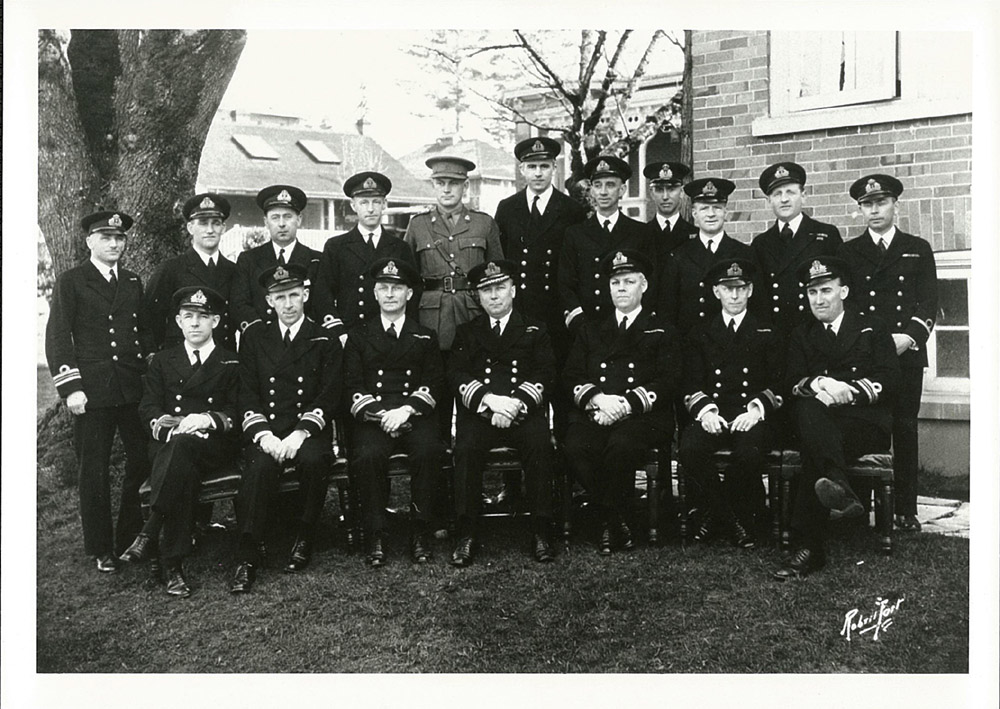
On 27 May, 1932, Commander Brodeur was appointed Commanding Officer HMCS Naden and Commander-in-Charge Esquimalt. The Brodeur family was living at that time in the Commander’s Residence in Naden – the same building which, in 1978, became the Victor G. Brodeur School. This photograph taken in 1933 shows Commander Brodeur and his staff. Their names, left to right, are: Front row – F.L. Houghton, H.R. Tingley, W.J.R. Beech, V.G. Brodeur, J.D. Laurie. Back row – A.C. Wurtele, Baker, Seabrook, T.H. Evans, Lecky, Neron, Brown, McMaster (Photo from the personal archives of Nigel Brodeur)
The Admirals Medal
In 1985 the Canadian Navy celebrated its 75th anniversary. To mark the occasion, while incidentally underscoring the intricate role played by their families in the Navy over that three-quarters of a century, three vice admirals holding senior Canadian Armed Forces appointments established an award named for their fathers who also had been flag officers in the RCN:
The appropriately named Admirals’ Medal is awarded annually to recognize outstanding achievement in the areas of maritime-related science, technology, and academic studies, or for the application of practical maritime skills warranting special attention. To reinforce the connection of the notion of a “Family Navy” past to the Navy Family of the present, typically the medal has been presented by a senior serving flag officer of the RCN.
Brodeur Family: An RCN Dynasty
Within the panoply of the Family Navy, one name has the special distinction of having had three successive generations hold positions of significant import to Canada’s Navy – the Brodeurs.
More than an inter-generational line of service, their family history has been intricately entwined with that of the Navy since its very inception:

Naden Building 20, which was once the home of Ecole Victor G. Brodeur, is now the office and archives of the CFB Esquimalt Naval and Military Museum. (Photo from the collection of the CFB Esquimalt Naval and Military Museum).
With their consecutive achievements spanning most of the first century of the Royal Canadian Navy, together the three generations of the Brodeur family constitute a true Canadian naval dynasty.
While the outlines of their legacy are well-enough known, many of the details would have been lost but for the foresight of Nigel to preserve the family papers (a rarity amongst senior Canadian naval officers) – in the early-1980s he donated the papers of his grandfather Louis Philippe and father Victor Gabriel to the Manuscript Division of the National Archives, and more recently he deposited his own papers with the Directorate of History & Heritage in NDHQ Ottawa.
This Museum is privileged to have played its own special part in keeping the family legacy alive. Most prominently, our principal building was formerly the residence of the Commanding Officer on the Pacific Coast, in which Victor Gabriel and his family lived at various times through the 1930s. In the post-war period it served a range of administrative purposes, eventually becoming the francophone elementary school which in 1977 was named Ecole Victor-Brodeur in memory of the first franco-canadien flag officer (in 1985 the school moved off base to its present location on Head Street, but retains the name). Less prominently, we are pleased to have assisted in the transfer recently of Nigel’s papers to the Directorate of History & Heritage.
Louis Philippe Brodeur

The Honourable Louis Philippe Brodeur, M.P. for Rouville, Quebec, as Minister of Inland Revenue, 1905. (Library and Archives Canada photo, MIKAN #3427148)
Louis Philippe Brodeur was born 21 August 1862 in Beloeil, Lower Canada, the son of a Rouges Patriote and grew up in a political family. He worked as a young lawyer with Honoré Mercier (future Liberal premier of Quebec) before establishing his own firm with future Senator Raoul Dandurand.
He was first elected to the Canadian House of Commons in 1891, as the Liberal Member for Rouville. When the Liberals won the 1896 election he was appointed Deputy Speaker, and eventually became the Speaker following the 1900 election. His rise through the party ranks continued, with Laurier bringing Louis Philippe into Cabinet initially as Minister of Inland Revenue in January 1904 and then in February 1906 as Minister of Marine & Fisheries, coincidentally making him his principal adviser in Quebec with responsibility for patronage in the province.
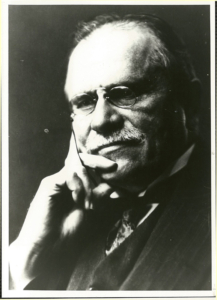
The Honourable Louis Philippe Brodeur, Lieutenant Governor of the Province of Quebec, 1923. (Library and Archives Canada photo, MIKAN #3213089)
As one of Laurier’s trusted advisers, Louis Philippe joined him and Minister of Militia & Defence Sir Frederick Borden to represent Canada at the April 1907 Colonial Conference in London. He shared Laurier’s belief that Canada should take charge of its own affairs, so in response to the contentious Admiralty proposal for centralization of the naval defence of the Empire, Louis Philippe proclaimed that the Canadian government would develop the Fisheries Protection Service into “the nucleus of a navy.” Within the year, he had re-organized his Department to bring those plans into effect. At the special Imperial Conference on Defence in August 1909, he secured British agreement that the self-governing dominions could organize their own naval defence, in Canada’s case around the loan of a pair of British cruisers, one for each coast.
Louis Philippe spent the fall of 1909 preparing a bill to establish a Canadian Naval Service. Regrettably he was struck with a serious illness before it could be introduced, and indeed still was absent when the Naval Service Act received Royal Assent on 4 May 1910. But he had worked to change the cruiser loan into an outright purchase, and was on hand for the arrival of HMCS Niobe in Halifax on 21 October 1910.
Louis Philippe accompanied Laurier to the Coronation of King George V in August 1911, along with a contingent of sailors from Niobe which included his son Midshipman Victor Gabriel. Due his lingering ill health, he decided not to run in the September general election, which the Liberals lost in part because of opposition to the Navy in Quebec.
Still, for nearly a decade Louis Philippe had been the most important Liberal in Quebec next to Laurier, and the Prime Minister rewarded his long time loyalist with an appointment to the Supreme Court of Canada on 11 August 1911. His judicial career has been characterized as “rather uneventful,” but he remained active in Liberal party circles, and in the fall of 1923 Prime Minister William Lyon Mackenzie King appointed him Lieutenant-Governor of Quebec. He was sworn in on 31 October, but his tenure was brief as he died of an intestinal haemorrhage on 2 January 1924.
Victor Gabriel Brodeur
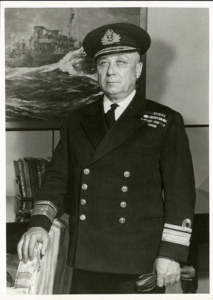
Rear-Admiral Victor Gabriel Brodeur in 1946, shortly before his retirement as Commanding Officer Pacific Coast. (Photo from the personal archives of Nigel Brodeur)
Victor Gabriel Brodeur was born in Beloil, Quebec, on 17 July 1892, the year after his father was first elected to the federal Parliament, and came of age as Louis Philippe was turning his attention to building the “nucleus of a navy” around the fisheries cruiser CGS Canada. So it was perhaps not surprising that Victor Gabriel was amongst the first class of seven cadets to join that ship in October 1909 in anticipation of the formation of the RCN. With the arrival of HMCS Niobe a year later, they all transferred as midshipmen to the warship, and in 1911 he was one of the two Gunroom members of the contingent that went to London for the Coronation of King George V.
Other than notably becoming the first franco-canadien flag officer, Victor Gabriel’s 37 years of service were typical of his generation, with a whirlwind mixture of appointments ashore and afloat at all ranks in both the Royal Canadian (RCN) and British Navies (RN). An overview reveals that fully 16 of his years were spent at sea, and his senior Royal Navy appointments included a period (1934-37) as Commander (executive officer) of the cruiser HMS Durban in the Mediterranean Fleet, followed by two years attached to the Operations Division of the Admiralty, and then another year at the Imperial Defence College in London. An earlier career highlight was that he was the first RCN officer to gain a Gunnery specialty (in 1920) at HMS Excellent.
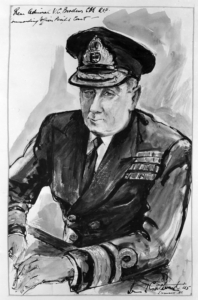
Sketch of Victor Gabriel Brodeur as Rear Admiral and Commander of the Pacific Coast Region (Library and Archives Canada image, ID #3608403)
With a career encompassing both World Wars and the tumultuous inter-war period, Victor Gabriel saw much action. He earned his Bridge Watchkeeping Certificate in HMS Berwick as that cruiser stood by the Mexican Revolution of 1914; he then passed the whole of the Great War at sea with the RN, as a Turret Officer first in the iconic battleship HMS Dreadnought (absent at Jutland, but involved in some smaller actions in Home Waters) and later the cruiser HMS Caradoc in the Baltic for the Russian Revolution. Later, in command of HMCS Skeena and supported by Vancouver, he saw to the protection of British interests during El Salvador’s “la matanza [the massacre]” troubles of January 1932.
Victor Gabriel had a succession of destroyer commands in the RCN, beginning with Champlain in Esquimalt in 1929; he then commissioned Skeena in Portsmouth in 1931 and brought her around to the west coast; later as Captain(D) he returned to Portsmouth to commission Fraser and St Laurent in 1937, and then Ottawa and Restigouche in 1938. In between those last two events, he had commanded the Canadian flotilla of Skeena and Saguenay at the Fleet Review off Spithead for the Coronation of King George VI and Queen Elizabeth in May 1938.
His first appointment ashore with the RCN (1922-25) significantly was as Senior Staff Officer to the Director of the Naval Staff, Captain Walter Hose, when amongst other things he was instrumental in the establishment of the Royal Canadian Naval Volunteer Reserve. At different times through the interwar period he was commander-in-charge of the shore establishments HMC Ships Stadacona (Halifax) and Naden (Esquimalt).
At the outbreak of the Second World War, Victor Gabriel was Commander of the Pacific Coast Region, and saw to planning for the defence of the Strait of Juan de Fuca and the formation of the Fisherman’s Reserve. As the scope of the war broadened, in 1940 he was promoted Commodore and appointed as the Canadian Naval Attaché in Washington DC, and in 1941 was promoted to Rear Admiral when the attaché position was re-styled the Naval Member of the Canadian Joint Staff.
Victor Gabriel returned to British Columbia in September 1943 as Commanding Officer Pacific Coast, this time taking up residence in Vancouver, where the coastal headquarters of the three armed services had been co-located at the site of RCAF Station Jericho Beach (the RCN establishment was known as HMCS Burrard). He remained in that appointment until retirement in 1946, and continued living in Vancouver until his death on 6 October 1976.
Nigel D. Brodeur

Nigel D. Brodeur, as Deputy Chief of Defence Staff, accompanied by Major General Dave Wightman and Major General John Sharpe, inspects the Princess Patricia’s Canadian Light Infantry (PPCLI) contingent during the Canadian Forces Europe Change of Command, 01 August, 1986. (Photo from the archives of the Directorate of History and Heritage, with special thanks to Emilie Vandal)
Nigel David Brodeur was born in Victoria, BC, on 18 June 1932, during the first occasion his father Victor Gabriel was Commanding Officer of HMCS Naden. He entered the Canadian Services College Royal Roads in 1950 when it was still a 2-year program, joining the RCN upon graduation as a midshipman in 1952. He was among one of the earliest classes to do all of his “big ship time” in the RCN instead of the RN, in the cruiser Ontario and then the carrier Magnificent, before completing his sub-lieutenant courses in England. On returning to Canada, he spent the latter half of the 1950s serving in a variety of junior officer positions in the Prestonian-class frigates HMC Ships Sussexvale and Beacon Hill.
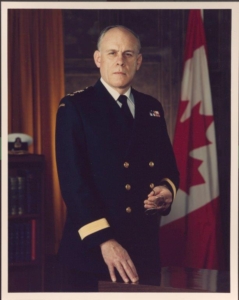
Nigel Brodeur’s official portrait on his promotion to Vice Admiral and appointment as Deputy Chief of Defence Staff, July, 1985. (Photo courtesy of the Directorate of History and Heritage, with special thanks to DHH Chief Archivist Emilie Vandal)
As the RCN continued to Canadianize its training in the post-war period, Nigel found himself on the Second Weapons Officers’ Course in Halifax in 1960, subsequently serving as the Weapons Officer in HMCS Kootenay at sea during the Cuban Missile Crisis of October-November 1962. Following a four-year stint ashore in Halifax, first in the Fleet School and then in Maritime Command Headquarters, in December 1966 he assumed command of HMCS Terra Nova, a highlight of which was taking part in the Centennial Fleet Review. Promoted Captain(N) in 1972 to be Commandant of the Maritime Warfare School in Halifax, his next (and ultimately final) sea-going appointment was as Commander of the Halifax-based Fifth Canadian Destroyer Squadron (1974-76).
During that time, he came to appreciate the need to revitalize the Canadian fleet, when for the NATO Exercise Ocean Safari 75 his squadron of the aging pre-DELEX steam destroyers Fraser, Nipigon and Skeena were relegated as the Orange opposing forces because of their “obsolete” communications fits that were unable to integrate with the main Blue force. Fortunately for the Navy, much of Nigel’s subsequent career found him in positions to change all that. After attending the National Defence College in 1976 he went to Ottawa as Director of Maritime Requirements (Sea) where he oversaw drafting of the statement of requirements for what would become the Canadian Patrol Frigate. He remained a major influencer of that project when promoted Commodore in 1978 to be Director General Maritime Doctrine and Operations, and then Rear Admiral in 1980 to be Chief of Maritime Doctrine and Operations, the senior “naval” appointment in the integrated NDHQ in Ottawa (Maritime Command was then still headquartered in Halifax).
Nigel went to Norfolk Virginia in 1982 to serve as Deputy Chief-of-Staff Operations, Reinforcement and Resupply to NATO’s Supreme Allied Commander Atlantic, and (concurrently) as Chief of Staff to NATO’s Commander-in-Chief Western Atlantic.
His “retirement” to Victoria proved to be little of the sort. Nigel remained a major force for the promotion of a strong Canadian military, as co-director of the now-defunct Defence Associations National Network (DANN, 1988-2006), and a prolific author of articles and presentations to various naval and military periodicals.
Brodeur Navy Family Project - References
Photo Album
CFB Naval & Military Museum would like to thank the creative team behind “The Brodeur Family – An RCN Dynasty” digital exhibit: Dr Richard Gimblett, Clare Sharpe and Ardent West Creative.
We would also like to thank the following contributors to the “Brodeur Family Photo Album”: Library and Archives Canada, Nova Scotia Archives, the archives of the Directorate of History and Heritage (with special thanks to DHH Chief Archivist Emilie Vandal), Oak Bay News, and the personal archives of Nigel Brodeur